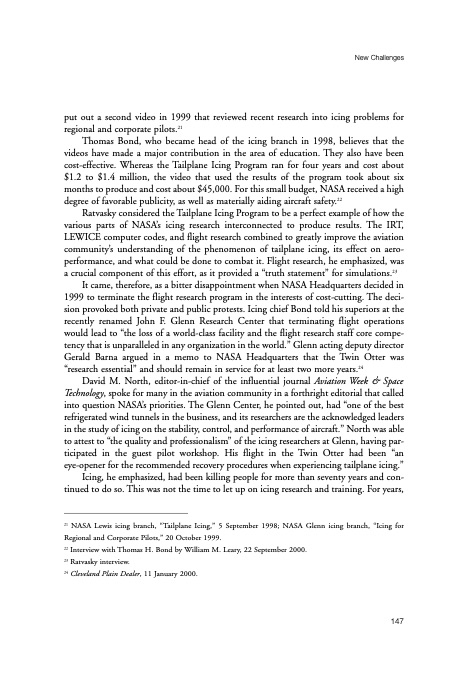
PDF Publication Title:
Text from PDF Page: 158
put out a second video in 1999 that reviewed recent research into icing problems for regional and corporate pilots.21 Thomas Bond, who became head of the icing branch in 1998, believes that the videos have made a major contribution in the area of education. They also have been cost-effective. Whereas the Tailplane Icing Program ran for four years and cost about $1.2 to $1.4 million, the video that used the results of the program took about six months to produce and cost about $45,000. For this small budget, NASA received a high degree of favorable publicity, as well as materially aiding aircraft safety.22 Ratvasky considered the Tailplane Icing Program to be a perfect example of how the various parts of NASA’s icing research interconnected to produce results. The IRT, LEWICE computer codes, and flight research combined to greatly improve the aviation community’s understanding of the phenomenon of tailplane icing, its effect on aero- performance, and what could be done to combat it. Flight research, he emphasized, was a crucial component of this effort, as it provided a “truth statement” for simulations.23 It came, therefore, as a bitter disappointment when NASA Headquarters decided in 1999 to terminate the flight research program in the interests of cost-cutting. The deci- sion provoked both private and public protests. Icing chief Bond told his superiors at the recently renamed John F. Glenn Research Center that terminating flight operations would lead to “the loss of a world-class facility and the flight research staff core compe- tency that is unparalleled in any organization in the world.” Glenn acting deputy director Gerald Barna argued in a memo to NASA Headquarters that the Twin Otter was “research essential” and should remain in service for at least two more years.24 David M. North, editor-in-chief of the influential journal Aviation Week & Space Technology, spoke for many in the aviation community in a forthright editorial that called into question NASA’s priorities. The Glenn Center, he pointed out, had “one of the best refrigerated wind tunnels in the business, and its researchers are the acknowledged leaders in the study of icing on the stability, control, and performance of aircraft.” North was able to attest to “the quality and professionalism” of the icing researchers at Glenn, having par- ticipated in the guest pilot workshop. His flight in the Twin Otter had been “an eye-opener for the recommended recovery procedures when experiencing tailplane icing.” Icing, he emphasized, had been killing people for more than seventy years and con- tinued to do so. This was not the time to let up on icing research and training. For years, New Challenges 21 NASA Lewis icing branch, “Tailplane Icing,” 5 September 1998; NASA Glenn icing branch, “Icing for Regional and Corporate Pilots,” 20 October 1999. 22 Interview with Thomas H. Bond by William M. Leary, 22 September 2000. 23 Ratvasky interview. 24 Cleveland Plain Dealer, 11 January 2000. 147PDF Image | History of NASA Icing Research Tunnel

PDF Search Title:
History of NASA Icing Research TunnelOriginal File Name Searched:
sp4226.pdfDIY PDF Search: Google It | Yahoo | Bing
NFT (Non Fungible Token): Buy our tech, design, development or system NFT and become part of our tech NFT network... More Info
IT XR Project Redstone NFT Available for Sale: NFT for high tech turbine design with one part 3D printed counter-rotating energy turbine. Be part of the future with this NFT. Can be bought and sold but only one design NFT exists. Royalties go to the developer (Infinity) to keep enhancing design and applications... More Info
Infinity Turbine IT XR Project Redstone Design: NFT for sale... NFT for high tech turbine design with one part 3D printed counter-rotating energy turbine. Includes all rights to this turbine design, including license for Fluid Handling Block I and II for the turbine assembly and housing. The NFT includes the blueprints (cad/cam), revenue streams, and all future development of the IT XR Project Redstone... More Info
Infinity Turbine ROT Radial Outflow Turbine 24 Design and Worldwide Rights: NFT for sale... NFT for the ROT 24 energy turbine. Be part of the future with this NFT. This design can be bought and sold but only one design NFT exists. You may manufacture the unit, or get the revenues from its sale from Infinity Turbine. Royalties go to the developer (Infinity) to keep enhancing design and applications... More Info
Infinity Supercritical CO2 10 Liter Extractor Design and Worldwide Rights: The Infinity Supercritical 10L CO2 extractor is for botanical oil extraction, which is rich in terpenes and can produce shelf ready full spectrum oil. With over 5 years of development, this industry leader mature extractor machine has been sold since 2015 and is part of many profitable businesses. The process can also be used for electrowinning, e-waste recycling, and lithium battery recycling, gold mining electronic wastes, precious metals. CO2 can also be used in a reverse fuel cell with nafion to make a gas-to-liquids fuel, such as methanol, ethanol and butanol or ethylene. Supercritical CO2 has also been used for treating nafion to make it more effective catalyst. This NFT is for the purchase of worldwide rights which includes the design. More Info
NFT (Non Fungible Token): Buy our tech, design, development or system NFT and become part of our tech NFT network... More Info
Infinity Turbine Products: Special for this month, any plans are $10,000 for complete Cad/Cam blueprints. License is for one build. Try before you buy a production license. May pay by Bitcoin or other Crypto. Products Page... More Info
| CONTACT TEL: 608-238-6001 Email: greg@infinityturbine.com | RSS | AMP |